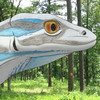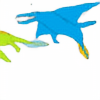HOME | DD
 AngryCyan — Early Fitoglacenian
AngryCyan — Early Fitoglacenian

#exoplanet #speculativeevolution #speculativebiology #speculativezoology #specevo #speculative_evolution
Published: 2020-01-10 13:13:03 +0000 UTC; Views: 395; Favourites: 2; Downloads: 0
Redirect to original
Description
The Fitoglacenian is the first geological age of Tletonatiuh since life was introduced, ending with the eon Abiotos (lifeless). It starts at 0My and lasts until 35My, being a relatively short period of time, being divided into two parts, the Early Fitoglacenian (0-23My) and the Late Fitoglacenian (23-35My). The whole period is characterized by a drop in global temperatures and an increase in oxygen levels, in addition to an increasing desertification. This is caused by the decrease of the greenhouse effect (which we will see its causes later) that has another interesting effect, since Tletonatiuh is very close to its star. The days are still warm at the equator, although cooler at the poles, but where you notice the difference is at night. Due to the thinner atmosphere than the terrestrial one, the remarkable reduction of CO2 has made the temperature differences between day and night more extreme. A hard blow for the reptiles of the planet.Earlier we talked about reduction in CO2 and an increase in O2. This gives a clear clue to the cause of this, the plants. But not all plants have affected in equal measure, and the most responsible are the Pines. This group of plants is exceptionally good at capturing atmospheric CO2, which feeds its rapid rate of growth. But in addition they were favored by another factor, the fall of the temperatures. The Pines spread through all the temperate climates of the planet, captured CO2 and reduced temperatures, which increased the extension of the temperate zones and the land available for the Pines, entering a vicious circle that ended up stabilizing, but the damage was already made, and Tletonatiuh's temperature was now 16ºC. Then the temperature eventually grew, reaching the previous levels of 23ºC at the end of the period cause of the volcanic activity, but that will happen in the Late Fitoglacenian.
And as great protagonists of this period, we will talk about the plants of the Early Fitoglacenian, starting with the Pines.
The Pines had begun to adapt to more quality areas, but with the fall of temperatures this seems to cease, although pine species now live in latitudes in what could be considered a tropical zone. These tropical varieties are shrubby, since their photosynthesis C3 is not effective enough to sustain the competitive growth of other plants, better adapted to this environment. In the north, however, something new has happened for the planet, it has snowed for the first time, and now Tletonatiuh presents its first polar ice caps, of small size. The Pines that once lived in these areas have died frozen, but at lower latitudes, the plants have adapted to the cold climates again, adopting the characteristic cone shape and the reappearance of the antifreeze sap.
Another group was not so favored by climate changes, and the Ferns were reduced. In the tropics they remain one of the dominant groups, but in less humid areas where they once survived, they now perish, withered and unable to reproduce, surviving only at the edges of rivers and lakes, where some have adapted as aquatic plants that They bury their rhizomes in the mud and leave their leaves below the surface. But over time a variety has arrived that can survive in those environments by storing nutrients and starch in its rhizome, but other invaders arrived earlier.
The Agaves, specifically the prairie Agaves, began a process to become a type of grass, although at the moment they are still shrubs in most cases. Its leaves are now less fleshy and ribbon-like, and spread by rhizomes, stolons and small fruits. In addition, its flowers are smaller and attract the ground bees of the prairies. Meanwhile, in the deserts, the Agaves have also adapted to the new pollinators. Lonely Bees are the norm here, and no longer just the Selfish Bees. To make things easier, flowers are now kept open for longer, and a large amount of energy is invested in the production of aromatic compounds that can be smelled a few kilometers away. In the steppes left behind by Ferns and Peanuts for desertification, some thorny and somewhat more conventional agaves survive, forming large swollen colonies like their prairie ancestors.
Cacti also live in the steppes, forming higth columns, and some have now developed lateral branches. Desert Cacti have also adapted to Solitary Bees and their flowers are large and showy, some can even act as a parasol when they are fully open. An interesting variety has developed refractive granules in their petals to make the flowers even more showy, which works best when the sun is low, bouncing its light rays in directions less perpendicular to the ground, and coinciding with less ardent hours in which the bees take advantage to look for flowers without fear of a mortal blow of heat. Other Cacti, this time from colder climates, have changed their morphology remarkably, and now they have rigid trunks and fleshy leaves derived from lateral branches, which grow in semicircumference, a form that helps them to keep warm in the freezing nights.
In high mountain areas, the Dandelions have had to adapt. The highest mountain peaks have been greatly affected by extreme changes in temperature between day and night, and the Dandelions there have died, leaving sterile peaks full of frost that melts in the mornings. In contrast, other areas have become more favorable for colonization, and now the lower mountain areas are full of Dandelion Trees, which grow tall and leafy, with a wide dome of star-shaped leaves. Even so, in the colder zones the Dandelions are forced to compete with the Pines, and it seems that they are not winning the battle, but their smaller cousins, herbaceous and shrubby forms, seem to be forming a diverse vegetation of undergrowth, with flowers of different colors and shapes (although circular ones predominate) that are pollinated by Bees and some Cockroaches.
But they are not the only trees that have evolved in Tletonatiuh. The Peanuts, more specifically the Arbusto Peanuts, have been favored by the retreat of the ferns, and have begun to grow in large, very large forms, in the drier forests and little by little they are gaining ground to the ferns in the tropical forests and in the forests around the rivers, although other varieties of the Peanut Tree are gaining ground in the drier steppes. Its leaves remain conservative, small and oval, but their flowers have begun to grow and become colorful for the new pollinators, and their fruits have begun to become more appetizing for animals, leaving behind the hard shells and changing them into fleshy covers, although its flavor is not sweet, but slightly bitter. But this has not been the only change in the Peanuts, another variety, a more conventional one that still buries its seeds in the soil, has adapted to the new desertification process in a curious way. Its flowers are pollinated, the developing fruit is buried, but this takes longer to separate from the mother plant and accumulates proteins and lipids to a considerable size for a peanut. Then, when conditions kill the mother plants, the Buried Peanut survives until the rains return and the seedlings can develop more quickly thanks to the large reserves of their seeds, allowing them to restart the cycle faster and start reproducing at older ages. early two or three weeks.
Finally, a new ecosystem has appeared in the oceans. We already knew the reefs of mussels, and the Kelp forests, but two new varieties of the second one have taken on a significant importance in the North Sea. The Forest of Urchins is sustained not only on the large columns of Kelp that float to the surface, but also the abundant sea Urchins that populate its soil, which serve as food to a large variety of specialized animals, from Giant Chimeras, to Lobsters with tongs specialized in crushing their shells, passing through an interesting group of Radiated Lamprey. The other variety is the Floating Forest, similar to the Sargassum forest of the Earth, it has its origin in Kepl plants that survived after some Sea Urchin ate its stem and ended up adrift, and later specialized in this pelagic environment . They are usually accompanied by Fishtail Chimeras and an interesting group of, of course, Sea Urchins.
The rest of the inhabitants of this new and cold Tletonatiuh will be explored in the next publications, and we will finally be able to see how the new fauna adapts for the first time to a changing environment.


















